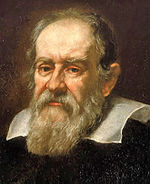
Astronomer
Encyclopedia

Scientist
A scientist in a broad sense is one engaging in a systematic activity to acquire knowledge. In a more restricted sense, a scientist is an individual who uses the scientific method. The person may be an expert in one or more areas of science. This article focuses on the more restricted use of the word...
who studies celestial bodies
Celestial Body
Celestial Body is a Croatian film directed by Lukas Nola. It was released in 2000....
such as planet
Planet
A planet is a celestial body orbiting a star or stellar remnant that is massive enough to be rounded by its own gravity, is not massive enough to cause thermonuclear fusion, and has cleared its neighbouring region of planetesimals.The term planet is ancient, with ties to history, science,...
s, star
Star
A star is a massive, luminous sphere of plasma held together by gravity. At the end of its lifetime, a star can also contain a proportion of degenerate matter. The nearest star to Earth is the Sun, which is the source of most of the energy on Earth...
s and galaxies
Galaxy
A galaxy is a massive, gravitationally bound system that consists of stars and stellar remnants, an interstellar medium of gas and dust, and an important but poorly understood component tentatively dubbed dark matter. The word galaxy is derived from the Greek galaxias , literally "milky", a...
.
Historically, astronomy
Astronomy
Astronomy is a natural science that deals with the study of celestial objects and phenomena that originate outside the atmosphere of Earth...
was more concerned with the classification and description of phenomena in the sky, while astrophysics
Astrophysics
Astrophysics is the branch of astronomy that deals with the physics of the universe, including the physical properties of celestial objects, as well as their interactions and behavior...
attempted to explain these phenomena and the differences between them using physical laws. Today, that distinction has mostly disappeared and the terms "astronomer" and "astrophysicist" are interchangeable. Professional astronomers are highly educated individuals who typically have a PhD
PHD
PHD may refer to:*Ph.D., a doctorate of philosophy*Ph.D. , a 1980s British group*PHD finger, a protein sequence*PHD Mountain Software, an outdoor clothing and equipment company*PhD Docbook renderer, an XML renderer...
in physics
Physics
Physics is a natural science that involves the study of matter and its motion through spacetime, along with related concepts such as energy and force. More broadly, it is the general analysis of nature, conducted in order to understand how the universe behaves.Physics is one of the oldest academic...
or astronomy and are employed by research institutions or universities
University
A university is an institution of higher education and research, which grants academic degrees in a variety of subjects. A university is an organisation that provides both undergraduate education and postgraduate education...
. They spend the majority of their time working on research, although they quite often have other duties such as teaching, building instruments, or aiding in the operation of an observatory. The number of professional astronomers in the United States is actually quite small. The American Astronomical Society
American Astronomical Society
The American Astronomical Society is an American society of professional astronomers and other interested individuals, headquartered in Washington, DC...
, which is the major organization of professional astronomers in North America, has approximately 7,700 members. This number includes scientists from other fields such as physics, geology
Geology
Geology is the science comprising the study of solid Earth, the rocks of which it is composed, and the processes by which it evolves. Geology gives insight into the history of the Earth, as it provides the primary evidence for plate tectonics, the evolutionary history of life, and past climates...
, and engineering
Engineering
Engineering is the discipline, art, skill and profession of acquiring and applying scientific, mathematical, economic, social, and practical knowledge, in order to design and build structures, machines, devices, systems, materials and processes that safely realize improvements to the lives of...
, whose research interests are closely related to astronomy. The International Astronomical Union
International Astronomical Union
The International Astronomical Union IAU is a collection of professional astronomers, at the Ph.D. level and beyond, active in professional research and education in astronomy...
comprises almost 10,145 members from 70 different countries who are involved in astronomical research at the PhD level and beyond.
While the number of professional astronomers worldwide is not much larger than the population of a small town
Town
A town is a human settlement larger than a village but smaller than a city. The size a settlement must be in order to be called a "town" varies considerably in different parts of the world, so that, for example, many American "small towns" seem to British people to be no more than villages, while...
, there is a huge community of amateur
Amateur
An amateur is generally considered a person attached to a particular pursuit, study, or science, without pay and often without formal training....
astronomers. Most cities have amateur astronomy
Amateur astronomy
Amateur astronomy, also called backyard astronomy and stargazing, is a hobby whose participants enjoy watching the night sky , and the plethora of objects found in it, mainly with portable telescopes and binoculars...
clubs that meet on a regular basis and often host star parties in their communities. The Astronomical Society of the Pacific
Astronomical Society of the Pacific
The Astronomical Society of the Pacific is a scientific and educational organization, founded in San Francisco on February 7, 1889. Its name derives from its origins on the Pacific Coast, but today it has members all over the country and the world...
is the largest general astronomical society in the world, comprising both professional and amateur astronomers as well as educators from 70 different nations. Like any hobby
Hobby
A hobby is a regular activity or interest that is undertaken for pleasure, typically done during one's leisure time.- Etymology :A hobby horse is a wooden or wickerwork toy made to be ridden just like a real horse...
, most people who think of themselves as amateur astronomers may devote a few hours a month to stargazing and reading the latest developments in research. However, amateurs span the range from so-called "armchair astronomers" to the very ambitious, who own science-grade telescope
Telescope
A telescope is an instrument that aids in the observation of remote objects by collecting electromagnetic radiation . The first known practical telescopes were invented in the Netherlands at the beginning of the 1600s , using glass lenses...
s and instruments with which they are able to make their own discoveries and assist professional astronomers in research.
Modern astronomers
Contrary to the classical image of an old astronomer peering through a telescope through the dark hours of the night, it is very rare for a modern professional astronomer to use an eyepiece on a larger telescopeTelescope
A telescope is an instrument that aids in the observation of remote objects by collecting electromagnetic radiation . The first known practical telescopes were invented in the Netherlands at the beginning of the 1600s , using glass lenses...
. It is far more common to use a charge-coupled device
Charge-coupled device
A charge-coupled device is a device for the movement of electrical charge, usually from within the device to an area where the charge can be manipulated, for example conversion into a digital value. This is achieved by "shifting" the signals between stages within the device one at a time...
camera to record a long, deep exposure, allowing a more sensitive image to be created because the light
Light
Light or visible light is electromagnetic radiation that is visible to the human eye, and is responsible for the sense of sight. Visible light has wavelength in a range from about 380 nanometres to about 740 nm, with a frequency range of about 405 THz to 790 THz...
is added over time. Before CCDs, photographic plates were a common method of observation. Modern astronomers spend relatively little time at telescopes - most spend a few weeks per year observing, and the rest of their time reducing the data (changing it from raw data to processed images) and analyzing it. Many astronomers work entirely from astronomical survey
Astronomical surveys
An astronomical survey is a general map or image of a region of the sky which lacks a specific observational target. Alternatively, an astronomical survey may comprise a set of many images of objects which share a common type or feature...
or space observatory
Space observatory
A space observatory is any instrument in outer space which is used for observation of distant planets, galaxies, and other outer space objects...
data. Others work with radio telescopes like the Very Large Array
Very Large Array
The Very Large Array is a radio astronomy observatory located on the Plains of San Agustin, between the towns of Magdalena and Datil, some fifty miles west of Socorro, New Mexico, USA...
, which is entirely automated, although it is maintained by telescope operators. Some astronomers do not work with data at all, but instead use computational simulations or analytical models to provide analysis of observed phenomena or make predictions for observational astronomers.
Astronomers who serve as faculty spend much of their time teaching undergraduate and graduate classes. Most universities also have outreach programs including public telescope time and sometimes planetarium
Planetarium
A planetarium is a theatre built primarily for presenting educational and entertaining shows about astronomy and the night sky, or for training in celestial navigation...
s as a public service and to encourage interest in the field.
See also
- List of astronomers
- List of Muslim astronomers
- Cosmologists
- List of Russian astronomers and astrophysicists

